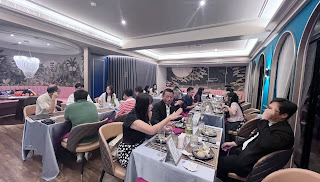GCIOSGF Newsletter 會訊
Host : WP
Edit: OF
How to deal with workplace problems?
Stress management
Bring to mind a conflict at work, and you’ll probably have the perpetrator in mind: your incompetent boss, that passive-aggressive colleague, or the resource-hoarding peer in another department. We spend an inordinate amount of time complaining about these people, avoiding them, and fighting with them. But if you want to manage conflict in the workplace, you can’t start with someone else. Usually there isn’t just one culprit, and if you want less fighting and a more enjoyable, productive workplace, you have to understand your own role in it and what you can do to break a vicious cycle that starts with frustration and stress and ends with workplace wars.
Constant challenges breed frustration. A healthy dose of frustration can be good, leading to determination and creativity. Unfortunately, instead of the occasional obstacle at work, we are often buried in an avalanche of problems. We don’t have the resources we need to do our job, and the goalposts keep moving. We blame the relentless, do-more-with-less nature of our shortsighted, quarterly-results-driven business climate for our frustration, or we pin responsibility on unending change or corporate culture. Whatever the reason, many of us are chronically frustrated at work.
Toxic emotions are stressful. Chronic frustration often morphs into fear and anger — “destructive emotions” that serve as an early warning system that we’re in danger. When the alarm rings, our bodies go into high alert, adrenaline and hormones course through our veins, muscles tighten so that we can move quickly, hands sweat, and breathing and heart rates speed up. This would all be well and good if it happened infrequently and saved us from actual danger. Unfortunately, frustration, low-grade fear, irritation, and even rage are familiar companions at work. Many of us are hyperalert all the time. We don’t thrive physically, we are disengaged and unhappy at work, and our brains don’t work properly.
Stress feeds conflict — and conflict breeds anger, resentment, and unhappiness. It’s easy to fool ourselves into thinking that stress isn’t all bad. In fact, when we’re under pressure, we may perform well on routine, well-rehearsed tasks. But when we’re under chronic stress, our complex thinking, reasoning, and social skills all suffer. Our ability to process and use information is compromised, as is our judgment. We have more difficulty with being flexible or open to new ideas, and we start seeing things in simplistic ways. We overreact to minor irritants, and everything and everyone starts looking like a threat. In this state, we are more likely to cause problems than solve them — especially in relationships.
This is when the vicious cycle becomes an endless loop. We don’t think straight. We pick fights. People aren’t pleased, and they let us know. Stress escalates, and our reasoning and behavior suffer even more. We lash out, hide out, or opt out.
A Three-Step Process to Interrupt the Vicious Cycle
If you want to break this cycle and have fewer destructive conflicts at work, the first step is to become more aware of your feelings and reactions to pressure and stress. The second step is to consciously manage your emotions, and the third is to start seeing people as people, not as threats.
Step 1: Develop self-awareness. To interrupt the frustration-stress-conflict cycle, you need to begin by recognizing what causes you to feel thwarted, scared, or threatened and what drives you to the battleground. This sounds easy, but even well-intentioned people typically put self-reflection last on the list — there just aren’t enough hours in the day. Telling yourself you don’t have time or are not inclined to “work on yourself” will keep you stuck in a bunker mentality at work. Instead, make time and tap into curiosity and courage to try to figure out what kinds of situations (and people) send you into the stratosphere. The more you know about your triggers, the better you can control your emotions.
YOU AND YOUR TEAM SERIES
Conflict
How to Control Your Emotions During a Difficult Conversation
Amy Gallo
How Self-Managed Teams Can Resolve Conflict
Amit Maimon
Even Experienced Executives Avoid Conflict
Ron Ashkenas
Step 2: Employ emotional self-control. Once you’re aware of the emotions that are driving your behavior, you can employ another important emotional intelligence competency: emotional self-control. This is what enables us to check and channel our emotions so that we don’t get stuck in a permanent amygdala hijack. We can manage negative feelings, see reality through a clear lens, and stop lashing out when we feel threatened.
Step 3: Build friendships at work. To minimize stress and conflict at work, we need to replace “I, me, mine” with “We, us, ours.” We need to stop seeing each other in terms of what we can get, and replace it with what we can give. This shift would result in less stress and fewer negative emotions. It would also lead to warmer, friendlier relationships — something most people need and want at work.
Developing self-awareness, increasing your emotional self-control, and recharging relationships at work takes commitment, but you don’t have to remake yourself to improve how you deal with strife. Here are a few practical tips to help you with the above steps:
Build mindfulness practices into your daily life. Mindfulness practices like yoga, meditation, deep breathing, and taking a solitary walk are invaluable when it comes to developing self-awareness, learning to manage our emotions, and short-circuiting the stress response. The research is mounting by the day: Even a few minutes of slow, deep breathing several times a day helps us to clear our minds, calm down, and choose our actions more consciously.
Schedule time for self-reflection. Like mindfulness practices, self-reflection helps tremendously with self-awareness and self-control. It’s hard to find time to think about our viewpoints and actions in our always-on world, however. So start small. You might, for example, reserve 20 minutes at the end of each week to reflect on what went well and what didn’t. But remember: Don’t fall prey to the “beat myself up” trap and spend this time lamenting what you didn’t get done or what you should’ve done differently. All that does is engender more stress.
Lean in to your natural empathy and compassion. Concern for others, empathy, and compassion help us to survive and thrive. Like self-reflection, this muscle may not be one you use often at work. But you can get better pretty quickly if you make a point to ask yourself questions that help you understand others’ points of view. Try these:
What is he thinking and feeling about the situation?
How is she different from me? How are we the same?
What can I do to make him feel better about this situation and about me?
As you ask yourself these questions, remember that we all have a story — loves, sorrows, and joys in life and at work. And chances are that while another person’s story might seem different from yours, our human experiences are remarkably similar. As tempting as it is to blame others for our strife-ridden companies, the best way to make work a more enjoyable, productive experience is to lean in to our natural empathy, learn to care for ourselves and others, and take responsibility for our feelings and actions. by
想到工作上的衝突,你可能會想到肇事者:你無能的老闆,那個消極攻擊的同事,或是另一個部門囤積資源的同事。我們花費過多的時間抱怨這些人、躲避他們、與他們爭吵。但如果你想管理工作場所的衝突,你不能從別人開始。通常罪魁禍首並不只有一個,如果你想要減少爭吵並擁有一個更愉快、更有成效的工作場所,你必須了解自己在其中的角色,以及你可以做些什麼來打破一個以沮喪和壓力開始並結束的惡性循環與職場戰爭。
持續的挑戰會滋生挫折感。一定程度的挫折是有好處的,可以帶來決心和創造力。不幸的是,我們在工作中並不是偶爾遇到障礙,而是經常被大量的問題所困擾。我們沒有完成工作所需的資源,而且目標不斷改變。我們將我們的挫敗感歸咎於短視、以季度業績為導向的商業環境的無情、少花錢多辦事的本質,或者我們將責任歸咎於無休止的變革或企業文化。無論出於何種原因,我們中的許多人都長期在工作中感到沮喪。
有毒的情緒會帶來壓力。長期的沮喪常常會演變成恐懼和憤怒——“破壞性情緒”,作為我們處於危險之中的早期預警系統。當警報響起時,我們的身體進入高度戒備狀態,腎上腺素和荷爾蒙在我們的靜脈中流動,肌肉收緊以便我們能夠快速移動,手上出汗,呼吸和心率加快。如果這種情況很少發生並且能夠使我們免受實際危險,那就太好了。不幸的是,挫折感、低級恐懼、惱怒,甚至憤怒是工作中常見的夥伴。我們中的許多人一直處於高度警覺的狀態。我們的身體不健康,工作不投入、不開心,大腦也無法正常運作。
壓力助長衝突-而衝突又會滋長憤怒、怨恨和不快樂。我們很容易欺騙自己,認為壓力不都是壞事。事實上,當我們面臨壓力時,我們可能會在例行的、經過充分排練的任務上表現出色。但當我們長期處於壓力之下時,我們的複雜思維、推理和社交技能都會受到影響。我們處理和使用資訊的能力受到損害,我們的判斷力也受到損害。我們更難以保持靈活性或接受新想法,並且開始以簡單化的方式看待事物。我們對輕微的刺激反應過度,一切事物和每個人都開始看起來像是威脅。在這種狀態下,我們更有可能製造問題而不是解決問題——尤其是在人際關係中。
這就是惡性循環變成無限循環的時候。我們不直接思考。我們挑釁。人們不高興,他們讓我們知道。壓力會不斷升級,我們的推理和行為會受到更大的影響。我們猛烈抨擊、躲藏或選擇退出。
中斷惡性循環的三步驟過程
如果你想打破這個循環並減少工作中的破壞性衝突,第一步就是更了解你對壓力和壓力的感受和反應。第二步是有意識地管理你的情緒,第三步是開始將人們視為人,而不是威脅。
第一步:培養自我意識。為了打破挫折-壓力-衝突的循環,你需要先認清是什麼讓你感到受挫、害怕或威脅,以及是什麼驅使你走向戰場。這聽起來很容易,但即使是善意的人通常也會把自我反思放在最後——一天中沒有足夠的時間。告訴自己你沒有時間或不願意「為自己工作」會讓你在工作中陷入困境。相反,騰出時間,發揮好奇心和勇氣,試著弄清楚什麼樣的情況(和人)會讓你進入平流層。您對觸發因素了解越多,就越能控制自己的情緒。
第二步:運用情緒自我控制。一旦你意識到驅動你行為的情緒,你就可以運用另一個重要的情緒智商能力:情緒自我控制。這使我們能夠檢查和引導我們的情緒,這樣我們就不會陷入永久性的杏仁核劫持。我們可以管理負面情緒,透過清晰的鏡頭看待現實,並在感到威脅時停止猛烈抨擊。
第三步:在工作中建立友誼。為了最大限度地減少工作中的壓力和衝突,我們需要用「我們,我們,我們的」來代替「我,我,我的」。我們需要停止以我們能得到什麼來看待彼此,而以我們能給予什麼來取代它。這種轉變會減少壓力和負面情緒。它還會帶來更溫暖、更友好的關係——這是大多數人在工作中需要和想要的。
發展自我意識、增強情緒自控力以及在工作中重新建立人際關係都需要付出努力,但你不必重塑自己來改善處理衝突的方式。以下是一些實用技巧,可協助您完成上述步驟:
將正念練習融入您的日常生活中。瑜珈、冥想、深呼吸和獨自散步等正念練習對於發展自我意識、學習管理情緒和縮短壓力反應非常有價值。研究與日俱增:即使是每天數次緩慢深呼吸幾分鐘,也能幫助我們理清思緒、平靜下來,並更有意識地選擇我們的行動。
安排自我反思的時間。就像正念練習一樣,自我反思對自我意識和自我控制有很大幫助。然而,在我們這個永遠在線的世界裡,很難找到時間來思考我們的觀點和行為。所以從小事做起。例如,您可以在每週結束時預留 20 分鐘來反思哪些進展順利,哪些進展不佳。但請記住:不要陷入「打敗自己」的陷阱,並花時間哀嘆自己沒有完成的事情或應該以不同的方式做的事情。這樣做只會帶來更多的壓力。
依靠你天生的同理心和同情心。對他人的關懷、同理心和同情心有助於我們生存和發展。就像自我反省一樣,這塊肌肉可能不是你在工作中經常使用的肌肉。但如果你主動問自己一些問題來幫助你理解別人的觀點,你很快就能變得更好。試試這些:
他對這種情況有什麼想法和感覺?
她和我有什麼不同?我們怎麼一樣?
我該怎麼做才能讓他對這種情況和我感覺更好?
當你問自己這些問題時,請記住,我們都有一個故事——生活和工作中的愛、悲傷和歡樂。雖然另一個人的故事可能與你的故事不同,但我們人類的經驗很可能非常相似。儘管很容易將我們充滿衝突的公司歸咎於他人,但讓工作變得更加愉快、富有成效的體驗的最佳方法是依靠我們天生的同理心,學會關心自己和他人,並對我們的感受負責和行動。
















































































